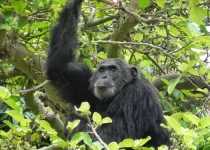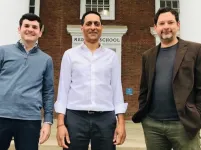(Press-News.org) It's well established that infectious disease is the greatest threat to the endangered chimpanzees made famous by the field studies of Jane Goodall at Gombe National Park in Tanzania. Now, new research led by scientists at Emory University shows that nearly half of the fecal samples from wild chimpanzees contain bacteria that is resistant to a major class of antibiotics commonly used by people in the vicinity of the park.
The journal Pathogens published the findings.
"Our results suggest that antibiotic-resistant bacteria is actually spreading from people to non-human primates by making its way into the local watershed," says Thomas Gillespie, senior author of the study and associate professor in Emory's Department of Environmental Sciences and Rollins School of Public Health. "People are bathing and washing in the streams, contaminating the water with drug-resistant bacteria where wild chimpanzees and baboons drink."
The researchers tested for genes conferring resistance to sulfonamides -- drugs often used by people in the region to treat diarrheal diseases -- in fecal samples from humans, domestic animals, chimpanzees and baboons in and around Gombe National Park. They also tested stream water used by these groups.
Sulfonamide resistance appeared in 74 percent of the human samples overall, 48 percent of chimpanzee samples, 34 percent of baboon samples, and 17 percent of the domestic animal samples. Sulfonamide also showed up in 19 percent of the samples taken from streams shared by people, domestic animals and wildlife.
The researchers also tested all the groups in the study for genes conferring resistance to tetracycline -- another class of antibiotics that is used much less frequently by people in the vicinity, likely due to its greater expense and the fact that it is less available in the area. As expected, very few of the fecal samples from any of the groups, and none of the water samples from the streams, showed evidence of tetracycline resistance.
First author of the study is Michelle Parsons, who did the work as an Emory doctoral student in Environmental Sciences. Parsons has since graduated and works at the Centers for Disease Control and Prevention (CDC). Co-authors include researchers from the Jane Goodall Institute, the CDC, the University of Minnesota and Franklin and Marshall College.
Gillespie is a disease ecologist who helped pioneer the "One Health" approach to protect humans, ecosystems and biodiversity. His projects in Africa, including the collaboration with the Jane Goodall Institute in Tanzania, are focused on helping farmers subsisting amid fragmented forests co-exist with primates and other wildlife in ways that minimize the risk of pathogen exchange between species, known as "spillover." The virus that causes AIDS, for example, spilled over from chimpanzees to people.
"It's important to consider both sides of the story -- human health and well-being, as well as conservation of chimpanzees and other species," Gillespie says.
Human encroachment has taken a toll on the great apes, due to fragmented habitat and the exchange of pathogens. Today, the number of chimpanzees in Gombe National Park are down to about 95.
Diarrheal diseases are common in the area and people often turn to cheap sulfonamide antibiotics that are available without a prescription at small stores that act as informal pharmacies, selling drugs, soap and other necessities. Wild chimpanzees also suffer from wasting diseases that can be related to bacterial and other enteric pathogens that affect their ability to maintain calorie intake and absorb nutrients.
"The majority of people in our sampling harbored bacteria resistant to the sulfonamide medication they are taking," Gillespie says. "In those cases, they're spending their money on a drug that is not helping them get better. Overuse of such drugs creates the potential for more lethal, antibiotic-resistant 'super bugs' to emerge."
The research findings will now support the development of interventions. More guidance is needed locally regarding the proper use of antibiotics, Gillespie says. He adds that it is also important to improve hygiene for wash-related activities in area streams, as well as to improve disposal of human waste materials.
"By misusing antibiotics, people can actually harm not only themselves, but also the species they share an environment with," Gillespie says. "After drug-resistant bacteria jump into chimpanzees, it can further evolve with the chimpanzees and then spill back into humans. We need to be thinking about infectious diseases within evolutionary and ecological frameworks, something that's not often done in medicine."
INFORMATION:
The study was funded by the Morris Animal Foundation, the Emory Global Health Institute, the Arcus Foundation, the Leo S. Guthman Foundation and the National Institutes of Health.
Rhinelander, Wis., April 28, 2021-- A research team from the USDA Forest Service and the University of Missouri has developed a new contaminant prioritization tool that has the potential to increase the effectiveness of environmental approaches to landfill clean-up.
Phytoremediation - an environmental approach in which trees and other plants are used to control leachate and treat polluted water and soil - hinges on matching the capability of different tree species with the types of contaminants present in soil and water. Identifying the worst contaminants ...
LAWRENCE -- College students across the country struggle with a vicious cycle: Test anxiety triggers poor sleep, which in turn reduces performance on the tests that caused the anxiety in the first place.
New research from the University of Kansas just published in the International Journal of Behavioral Medicine is shedding light on this biopsychosocial process that can lead to poor grades, withdrawal from classes and even students who drop out. Indeed, about 40% of freshman don't return to their universities for a second year in the United States.
"We were interested in finding out what predicted students' performance in statistics classes ...
MINNEAPOLIS/ST.PAUL (04/28/2021) -- In a recent discovery by University of Minnesota Medical School, researchers uncovered a new way to potentially target and treat late-stage colorectal cancer - a disease that kills more than 50,000 people each year in the United States. The team identified a novel mechanism by which colorectal cancer cells evade an anti-tumor immune response, which helped them develop an exosome-based therapeutic strategy to potentially treat the disease.
"Late-stage colorectal cancer patients face enormous challenges with current treatment options. Most of the time, the patient's immune system cannot efficiently fight against tumors, even with the ...
Seasonally occurring fields of aufeis (icing) constitute an important resource for the water supply of the local population in the Upper Indus Basin. However, little research has been done on them so far. Geographers at the South Asia Institute of Heidelberg University have now examined the spreading of aufeis and, for the first time, created a full inventory of these aufeis fields. The more than 3,700 accumulations of laminated ice are important for these high mountain areas between South and Central Asia, particularly with respect to hydrology and climatology.
In the semi-arid Himalaya regions of India and Pakistan, meltwater from snow and glaciers plays an essential role for irrigation in local agriculture and hydropower generation. In ...
LOS ALAMOS, N.M., April 28, 2021--Analysis of data from a lightning mapper and a small, hand-held radiation detector has unexpectedly shed light on what a gamma-ray burst from lightning might look like - by observing neutrons generated from soil by very large cosmic-ray showers. The work took place at the High Altitude Water Cherenkov (HAWC) Cosmic Ray Observatory in Mexico.
"This was an accidental discovery," said Greg Bowers, a scientist at Los Alamos National Laboratory and lead author of the study published in Geophysical Research Letters. "We set up this system to study terrestrial gamma-ray flashes - or gamma-ray bursts from lightning - that are ...
New research from the University of Virginia School of Medicine has shed light on the No. 1 cause of epilepsy deaths, suggesting a long-sought answer for why some patients die unexpectedly following an epileptic seizure.
The researchers found that a certain type of seizure is associated with sudden death in a mouse model of epilepsy and that death occurred only when the seizure induced failure of the respiratory system.
The new understanding will help scientists in their efforts to develop ways to prevent sudden unexpected death in epilepsy (SUDEP). Based on their research, the UVA team has already identified potential approaches to stimulate breathing in the ...
Children and young adults with compromised immune systems, such as those undergoing cancer treatment, may experience a prolonged period of infection with SARS-CoV-2, the virus that causes COVID-19, and the extended duration of infection may increase the incidence of mutations. This case study was conducted by investigators at Children's Hospital Los Angeles and is published in the journal EBioMedicine.
Most people are infectious for about 10 days after first showing COVID-19 symptoms. In this study, researchers describe two children and a young adult with acute lymphoblastic leukemia who tested positive for SARS-CoV-2 for months. ...
UPTON, NY--Scientists characterized how the electronic states in a compound containing iron, tellurium, and selenium depend on local chemical concentrations. They discovered that superconductivity (conducting electricity without resistance), along with distinct magnetic correlations, appears when the local concentration of iron is sufficiently low; a coexisting electronic state existing only at the surface (topological surface state) arises when the concentration of tellurium is sufficiently high. Reported in Nature Materials, their findings point to the composition range necessary for topological superconductivity. Topological superconductivity could enable more ...
APRIL 28, 2021, NEW YORK - A Ludwig Cancer Research study has identified a previously unrecognized mechanism by which cancer cells of a relatively benign subtype of pancreatic tumors methodically revert--or "de-differentiate"--to a progenitor, or immature, state of cellular development to spawn highly aggressive tumors that are capable of metastasis to the liver and lymph nodes.
The study, led by Ludwig Lausanne's Douglas Hanahan and published in Cancer Discovery, a journal of the American Association for Cancer Research, also shows that engagement of the mechanism is associated with poorer outcomes in patients diagnosed with pancreatic neuroendocrine tumors (PanNETs). Further, its findings provide concrete evidence that such cellular de-differentiation, widely observed ...
April 28, 2021 - Injectable dermal fillers provide a minimally invasive approach to reduce facial lines and wrinkles while restoring volume and fullness in the face. More than 2.7 million dermal filler procedures were performed in 2019, according to the most recent statistics from the American Society of Plastic Surgeons (ASPS).
Even as the popularity of dermal fillers continues to skyrocket, plastic surgeons are still working out how to maximize their benefits for patients seeking nonsurgical facial rejuvenation. Most studies have used subjective rating systems, with little objective evidence on the outcomes achieved.
One recent study suggested that in addition to their "volumizing" effects, dermal fillers may also have variable "lifting" effects. Sebastian Cotofana, ...






